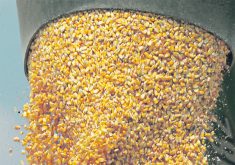You could drive a combine between the gap in official estimates of 2006 lentil acreage.
Statistics Canada predicts that Saskatchewan, home to 99 percent of last year’s lentil crop, will seed 1.3 million acres, down 40 percent from 2005 levels.
Saskatchewan Agriculture, based on a survey of 250 crop reporters, forecast 1.99 million acres for the province, down eight percent from last year’s 2.16 million acre crop.
The largest red lentil splitter in the Americas thinks the Saskatchewan Agriculture number is a little lofty and the Statistics Canada projection, which led to a sharp surge in No. 2 or better lentil prices on export markets, is too pessimistic.
Read Also

Chinese, Indian tariffs take toll on pea prices
The disruption of pea exports from Canada’s largest customers will likely result in slow pea exports for the remainder of the crop year.
“We feel that certainly it will settle somewhere between the two figures,” said Murad Al-Katib, president of Saskcan Pulse Trading.
Saskcan’s internal estimate is for 1.7 million acres.
Many in the trade question the Statistics Canada estimate, according to an April 27 market report published by Louis Dreyfus Canada.
Pulse crop processors think the decline will be smaller because circumstances have changed since farmers were surveyed in March.
“The rise in spot red lentil prices during the past month could have attracted more farmers to the crop who might have previously been planning to grow something else,” said Louis Dreyfus.
Al-Katib is projecting 700,000 acres of red lentils, which represents 41 percent of Saskcan’s total lentil estimate.
“Most folks would agree that for the first time in Canada’s history of growing lentils, red lentils will be the largest class of all types that we can grow,” he said.
That is because No. 2 reds are selling for about twice the price of No. 2 Laird and Richlea lentils.
Last year growers seeded about 400,000 acres of reds, which represented 18 percent of the total lentil crop, said Ray McVicar, special crops specialist with Saskatchewan Agriculture.
He agreed with Al-Katib that red lentil acreage is rising, although Saskatchewan Agriculture projects a more conservative number of 600,000 acres.
Al-Katib, who was speaking from Mersin, Turkey, where he was visiting Saskcan’s parent company Arbel Pulse Grain Industry & Trade S.A., is confident there will be a market for all the reds Canadian growers plan to seed.
“The ultimate disaster for Canada is a bumper crop in India and a bumper crop in Turkey all at once. We already know India does not have a bumper crop and I’m telling you I think Turkey is going to have a good crop but nothing that is going to blow our doors off.”
He said Turkey’s crop of reds, which is four to five weeks away from harvest, is projected to be above the 10-year average. But the world’s second largest exporter of lentils won’t harvest a “miracle crop” that would disrupt world supply.
“The stage is set for what I term to be a good year for Canadian export of red lentils,” said Al-Katib.
What concerns him is the surly mood of green lentil growers. If Statistics Canada’s survey of 17,100 farmers is accurate, there will be only 600,000 acres of large, medium and small green lentils.
He considers that an overreaction to last year’s overproduction of greens.
“Although I’ve been one to preach the transition from green to red, we certainly don’t want greens to fall off the map,” said Al-Katib.
He noted that while Agriculture Canada projects 600,000 tonnes of green lentil carryover from the 2005-06 crop, a lot of that supply is graded Extra 3 or No. 3., destined for discount markets.
“We will not have a lot of very good quality for the premium markets of the world,” said Al-Katib.















